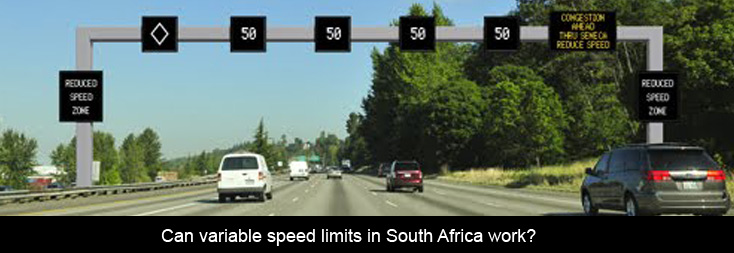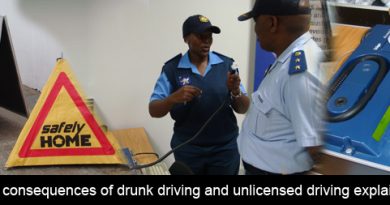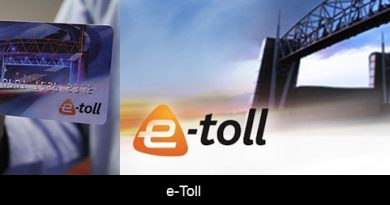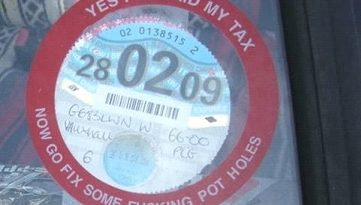Can variable speed limits in South Africa work?
The speed limit on South African roads is a controversial issue; some road users would say its only purpose is to enable poor local authorities to create income; other road users defiantly ignore it. There’re those who seem to be of the opinion that if the vehicle is expensive enough, the speed limit either doesn’t apply to them, or does not serve a road safety purpose.
A recent proposal from the Minister of Transport, to decrease the maximum speed limit from 120km/h to 100km/h, led to a public outcry. Still others argue that it is not so much the maximum speed that causes accidents but rather the difference in speeds, and they try to shift the blame to those who prefer (or are forced) to travel at lower speeds.
In 1999, following a fatal bus collission involving British tourists, the then Minister of Transport reduced the maximum speed limit for public transport vehicles (buses and minibus taxis) to 100km/h. Heavy vehicles were already limited to 80km/h. Speed limits vary, of course, not only according to vehicle type, but also according to the time of day, traffic conditions, work zone activities, weather conditions, and the lane in which the vehicle travels. So should we then focus our road safety approach on variable speed limits, for example different speed limits for different vehicles, or different drivers?
There are a number of safety-related reasons why different speed limits could in fact be applied to different types of vehicle. For example, because of the differences in mass, different vehicles have different stopping distances – a basic feature in safe operations. And related to the interaction between the tyres and the road surface is the ability of a vehicle to negotiate a horizontal curve.
Excessive speeds can lead to a vehicle slipping or overturning on a sharp curve. Furthermore, different types of vehicle have different safety features, such as crumble zones, passenger restraints, and electronic stability control.
The application of variable speed limits is not without problems, however, the most important of which is the ability to enforce them. Automatic speed cameras cannot differentiate between vehicle types, which is why only the highest limit would be enforced.
Speed cameras that are manually operated, or sophisticated apparatus with access to the SA vehicle data base (such as the speed-over-distance camera) would be necessary instead. And secondly, international research has shown that crashes accidents are minimised when there is little variation from the average speed, which is why many countries do not have variable speed limits for different types of vehicle.
The stopping distance argument in favour of variable speed limits is also becoming less important. It is true that generally, heavier vehicles need much better braking systems to fully make use of the available friction for the work necessary to reduce the large momentum of such vehicles at high speeds. But the introduction of antilock brakes has improved the braking performance of trucks, and recent research shows that while truck braking distances remain longer than passenger car braking distances on dry pavements. By contrast, on wet pavements, which are most critical to safety, the braking distances of trucks and passenger cars are nearly equal.
Probably the main reason for limiting the speeds of buses and minibus taxis, however, is passenger protection. Modern private passenger vehicles have a range of safety features that are not present in most public passenger transport vehicles, such as include seat belts, air bags, crumble zones, strengthened roof pillars (or roll bars in LDVs), brake assist, electronic stability control and many others. Yet because of the way in which South African data is collected, it’s not in fact known in whether buses, minibuses and trucks have a higher crash rate than other vehicles in terms of vehicle-kilometres travelled.
Also of note is the fact that in South Africa, legislation regarding the 80 km/h speed limit refers to heavy goods vehicles only. Why allow a higher speed limit for buses than for other heavy vehicles – or vice versa why force drivers of heavy goods vehicles to travel slower than heavy passenger vehicles? Some reason that the value of time is higher for passengers than for freight and therefore buses should be allowed higher speeds, but this is an economic decision and not one that relates to safety – the main reason given for speed limits. Economic decisions regarding vehicle travel should be taken by operators and not legislators.
Research conducted by the Federal Highway Administration has shown that the chance of being involved in a road crash follows a U-shaped distribution, with the minimum occurring when the vehicle is travelling at about the average speed of traffic, or slightly above. This is the basis of the argument that there should not be a speed limit differential (and thus travel speed differential) between heavy vehicles and other road vehicles. Indeed, there is concern that by increasing speed variance, differential speed limits may increase overall accident rates.
It should also be kept in mind that the effect of variable speeds on safety would be higher on two-lane, two-way roads where the opportunities for overtaking slower vehicles are limited (and more dangerous) as against multilane roads (two or more per direction).
Our research1 suggests that although there are various arguments for and against the use of variable speed limits to increase the safety on roads, it is difficult to effectively enforce different limits on the same road. Much research has shown no safety benefits in variable speed limits. It is clear, however, that minibus taxis and heavy vehicles do not adhere to their maximum speed limits. More than 60% exceed the limit and their 85th percentile speeds are nearly 20 km/h higher than the limit. It is clear that these limits should be reconsidered or at least enforced on a larger scale that is currently the case. If the limits are not enforced, there is clearly no justification for having them.
Variable speed limits (perhaps any speed limites) are not effectively enforced in South Africa. For variable speed limits to work, it is essential that the current limits for different vehicles be reconsidered.
When decisions are made on any speed limit or speed limit change it must be enforced effectively with intelligent cameras that can differentiate between vehicle types. And finally, if the need for a lower speed variance can be demonstrated, it can only be achieved by reducing and enforcing the maximum speed limit for all vehicles, and the reduction of maximum speed limits on two-lane two-way roads in line with international practice.
[By Christo Bester and MS Marais]
Christo Bester and MS Marais are both from the University of Stellenbosch, and will be speaking at the Southern African Transport Conference on Tuesday, 10 July 2012 at 10:30. For more information or to register, book your tickets at www.satc.org.za.




